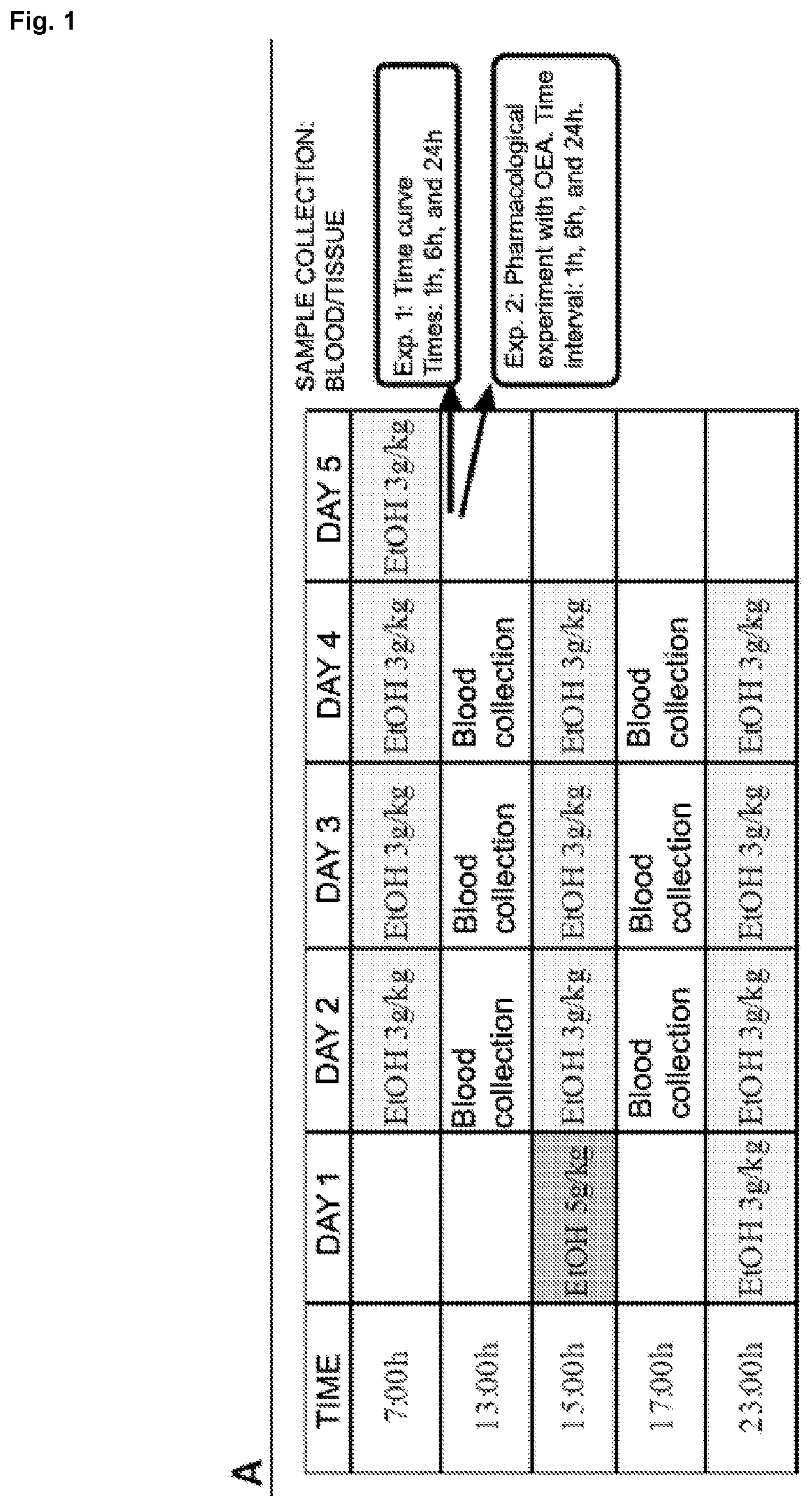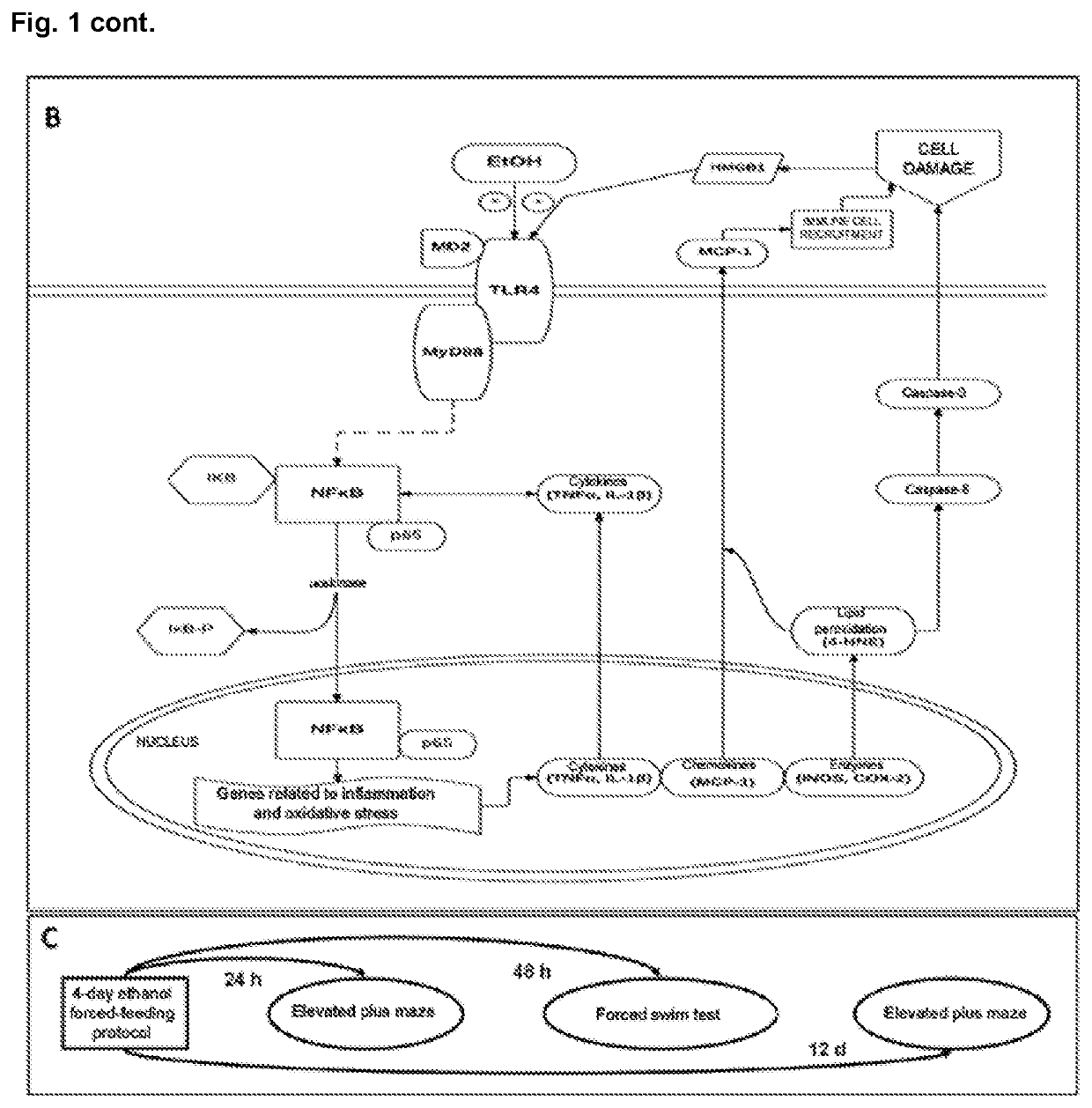Compositions for the prevention and/or treatment of alcohol use disorders
a technology for alcohol use disorders and compositions, applied in the field of compositions for the prevention and/or treatment of alcohol use disorders, can solve the problems of loss of balance, high number of side effects that may seriously affect the body, and affecting the quality of life of patients, so as to achieve the effect of preventing, relieving, and/or improving
- Summary
- Abstract
- Description
- Claims
- Application Information
AI Technical Summary
Benefits of technology
Problems solved by technology
Method used
Image
Examples
example 1
and Methods
[0240]Animals
[0241]87 male Wistar rats (from Harlan, Spain) weighing 250-300 g were used. The animals were housed in groups (n=4-6) in a 12-hour reverse light / dark cycle in normal temperature and humidity conditions. Standard food (A04 SAFE, Scientific Animal Food and Engineering, Augy, France) and ad libitum tap water were available in the cage. All the animals were kept under constant conditions for 10 days before the experiments.
[0242]All the experimental protocols complied with the guidelines of the Animal Protection Committee of the Universidad Complutense of Madrid, following European legislation (2010 / 63 / EU).
[0243]Treatment of Ethanol Intoxication
[0244]The animals were treated with intragastric (i.g.) ethanol 3 times a day using an i.g. cannula (16G needle, Fisher Scientific, Waltham, Mass., USA), following a protocol based on a slightly modified standard 4-day alcohol intoxication pattern (Bernier et al., 2002a, b) (FIG. 1A). The ethanol doses were administered ev...
example 2
e of Proinflammatory Markers in the Frontal Cortex Induced by Alcohol Intoxication and Increase in Plasma Corticosterone Levels
[0276]TNF-α of the frontal cortex was overexpressed 1 hour after the administration of ethanol [55% increase with respect to the control (80.29±17 pg / mg of protein)] and the cytokine content dropped 24 hours after treatment (FIG. 2A; F(3, 11)=9.45; p=0.0002). IL-1β showed a tendency to increase 1 h after exposure to ethanol [29% increase with respect to the control (75.5±6.6 pg / mg of protein)], but the data did not amount to being statistically significant (FIG. 2B).
[0277]The expression of NF-kB p65 subunit increased in the nuclear extracts of the frontal cortex 6 h after treatment with ethanol, and dropped 24 h after ethanol intoxication, when compared with the control group (FIG. 2C; F(3, 11)=20.48; p(3, 13)=6.73; p=0.0056) and COX-2 enzyme showed overexpression 6 h after the administration of ethanol (FIG. 2E; F(3, 13)=3.69; p=0.04). Finally, exposure to ...
example 3
anol Levels
[0279]BEL reached during the experiment was in the range described by others (Knapp and Crews et al., 1999; Obernier et al, 2002a, b; Crews et al, 2006). It was studied if OEA may modify BEL during days 2-4 of treatment with excessive alcohol (Table 1). The two-way repeated measure ANOVA detected differences in the BEL over the days of the intoxication protocol (F(2, 17)=10.17; p=0.0003; F(2, 17)=15.41; p(1, 17)=0.13; p=0.72, ns) or during post-feeding (F(1, 17)=0.18; p=0.67, n.s.). BEL also was determined right before removing the tissue (day 5), being 431.98±34.90 g / dl for the vehicle+ethanol group and 445.82±32.70 g / dl for the OEA+ethanol group (Student t-test, p=0.78, n.s.).
PUM
| Property | Measurement | Unit |
|---|---|---|
| time | aaaaa | aaaaa |
| time | aaaaa | aaaaa |
| time | aaaaa | aaaaa |
Abstract
Description
Claims
Application Information
 Login to View More
Login to View More - R&D
- Intellectual Property
- Life Sciences
- Materials
- Tech Scout
- Unparalleled Data Quality
- Higher Quality Content
- 60% Fewer Hallucinations
Browse by: Latest US Patents, China's latest patents, Technical Efficacy Thesaurus, Application Domain, Technology Topic, Popular Technical Reports.
© 2025 PatSnap. All rights reserved.Legal|Privacy policy|Modern Slavery Act Transparency Statement|Sitemap|About US| Contact US: help@patsnap.com



